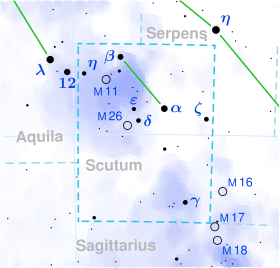
Summary
Gamma Scuti, Latinized from γ Scuti, is a single,[9] white-hued star in the southern constellation of Scutum. The apparent visual magnitude of 4.67[2] indicates this is a dim star but visible to the naked eye. Based upon an annual parallax shift of 10.21 mas as seen from Earth,[1] this star is located about 319 light years from the Sun. Currently it is moving towards the Solar System at 41 km/s, which means in 2.35 million years it will pass at just 20 ly (5.519 pc) distance,[10] probably becoming the brightest star in the night sky, at magnitude −2.1, for a period.[11]
| Observation data Epoch J2000 Equinox J2000 | |
|---|---|
| Constellation | Scutum |
| Right ascension | 18h 29m 11.85388s[1] |
| Declination | −14° 33′ 56.9319″[1] |
| Apparent magnitude (V) | 4.67[2] |
| Characteristics | |
| Spectral type | A2:V[3] |
| U−B color index | +0.04[4] |
| B−V color index | +0.07[4] |
| Astrometry | |
| Radial velocity (Rv) | -41.00[5] km/s |
| Proper motion (μ) | RA: +3.22[1] mas/yr Dec.: −4.02[1] mas/yr |
| Parallax (π) | 10.21 ± 0.24 mas[1] |
| Distance | 319 ± 8 ly (98 ± 2 pc) |
| Absolute magnitude (MV) | −0.28[2] |
| Details | |
| Mass | 2.91[6] M☉ |
| Radius | 4.1[7] R☉ |
| Luminosity | 150[6] L☉ |
| Surface gravity (log g) | 2.09[8] cgs |
| Temperature | 9,016[6] K |
| Rotational velocity (v sin i) | 222[6] km/s |
| Age | 237[8] Myr |
| Other designations | |
| Database references | |
| SIMBAD | data |
This is an A-type main-sequence star[3] with a stellar classification of A2:V.[3] At the age of 237 million years,[8] it is spinning rapidly with a projected rotational velocity of 222 km/s.[6] This is giving the star an oblate shape with a prominent equatorial bulge that is estimated to be 21% larger than the polar radius.[12] The star has an estimated 2.91[6] times the mass of the Sun and 4.1[7] times the Sun's radius. It is radiating 150 times the Sun's luminosity from its photosphere at an effective temperature of 9,016 K.[6]
References edit
- ^ a b c d e f Van Leeuwen, F. (2007). "Validation of the new Hipparcos reduction". Astronomy and Astrophysics. 474 (2): 653–664. arXiv:0708.1752. Bibcode:2007A&A...474..653V. doi:10.1051/0004-6361:20078357. S2CID 18759600. Vizier catalog entry
- ^ a b c Anderson, E.; Francis, Ch. (2012). "XHIP: An extended hipparcos compilation". Astronomy Letters. 38 (5): 331. arXiv:1108.4971. Bibcode:2012AstL...38..331A. doi:10.1134/S1063773712050015. S2CID 119257644. Vizier catalog entry
- ^ a b c Abt, Helmut A.; Morrell, Nidia I. (1995). "The Relation between Rotational Velocities and Spectral Peculiarities among A-Type Stars". Astrophysical Journal Supplement. 99: 135. Bibcode:1995ApJS...99..135A. doi:10.1086/192182.
- ^ a b Mallama, A. (2014). "Sloan Magnitudes for the Brightest Stars". The Journal of the American Association of Variable Star Observers. 42 (2): 443. Bibcode:2014JAVSO..42..443M.Vizier catalog entry
- ^ Gontcharov, G. A. (2006). "Pulkovo Compilation of Radial Velocities for 35 495 Hipparcos stars in a common system". Astronomy Letters. 32 (11): 759–771. arXiv:1606.08053. Bibcode:2006AstL...32..759G. doi:10.1134/S1063773706110065. S2CID 119231169.
- ^ a b c d e f g Zorec, J.; Royer, F. (2012). "Rotational velocities of A-type stars". Astronomy & Astrophysics. 537: A120. arXiv:1201.2052. Bibcode:2012A&A...537A.120Z. doi:10.1051/0004-6361/201117691. S2CID 55586789. Vizier catalog entry
- ^ a b Allende Prieto, C.; Lambert, D. L. (1999). "Fundamental parameters of nearby stars from the comparison with evolutionary calculations: Masses, radii and effective temperatures". Astronomy and Astrophysics. 352: 555–562. arXiv:astro-ph/9911002. Bibcode:1999A&A...352..555A. Vizier catalog entry
- ^ a b c David, Trevor J.; Hillenbrand, Lynne A. (2015). "The Ages of Early-Type Stars: Strömgren Photometric Methods Calibrated, Validated, Tested, and Applied to Hosts and Prospective Hosts of Directly Imaged Exoplanets". The Astrophysical Journal. 804 (2): 146. arXiv:1501.03154. Bibcode:2015ApJ...804..146D. doi:10.1088/0004-637X/804/2/146. S2CID 33401607. Vizier catalog entry
- ^ Eggleton, P. P.; Tokovinin, A. A. (September 2008), "A catalogue of multiplicity among bright stellar systems", Monthly Notices of the Royal Astronomical Society, 389 (2): 869–879, arXiv:0806.2878, Bibcode:2008MNRAS.389..869E, doi:10.1111/j.1365-2966.2008.13596.x, S2CID 14878976.
- ^ Bailer-Jones, C. A. L. (March 2015), "Close encounters of the stellar kind", Astronomy & Astrophysics, 575: 13, arXiv:1412.3648, Bibcode:2015A&A...575A..35B, doi:10.1051/0004-6361/201425221, S2CID 59039482, A35.
- ^ Kaler, Jim. "Gamma Scuti". Retrieved 2017-04-21.
- ^ van Belle, Gerard T. (March 2012), "Interferometric observations of rapidly rotating stars", The Astronomy and Astrophysics Review, 20 (1): 51, arXiv:1204.2572, Bibcode:2012A&ARv..20...51V, doi:10.1007/s00159-012-0051-2, S2CID 119273474.



